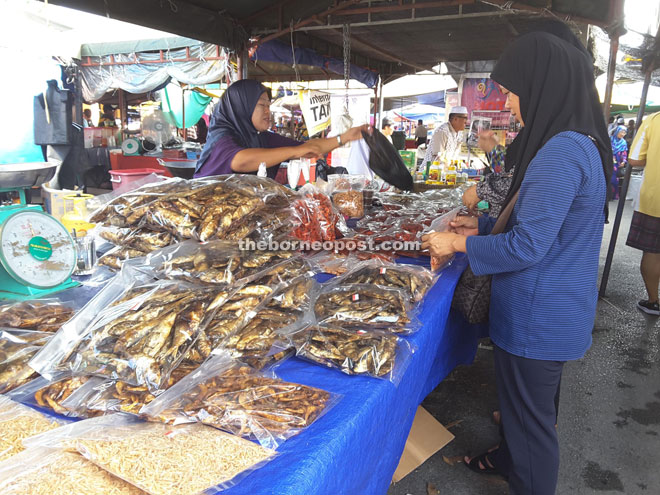
Brisk sales for Tahai products at Tamu Lawas.

Awang Tengah (third left) hands over a RM200,000 cheque to a village representative for the repair of jetty in the village. He also pledged to support redevelopment of four Ikan Tahai smokehouses in Kampung Punang.
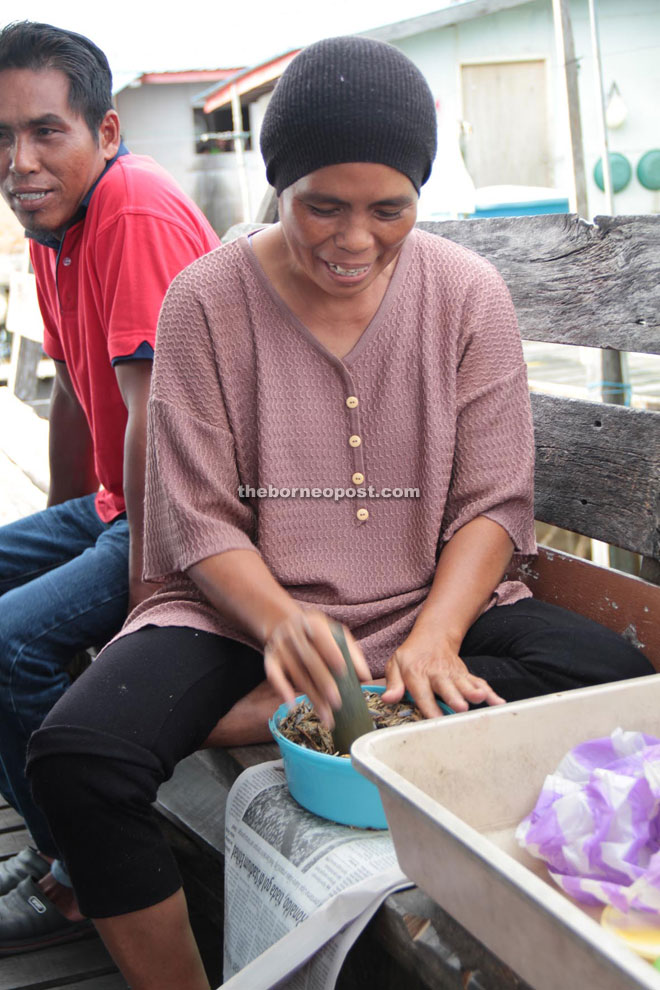
A villager pounds the smoked fish to be made into Sambal Ikan Tahai.
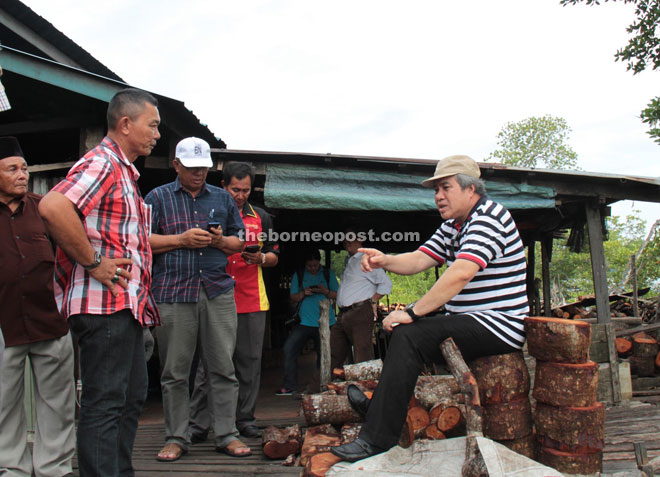
Awang Tengah at home sitting on a stake of cut Bakau wood, discussing with Awangku Tajudin (left) and the villagers on plans to rebuild four smokehouses in Kampung Punang.
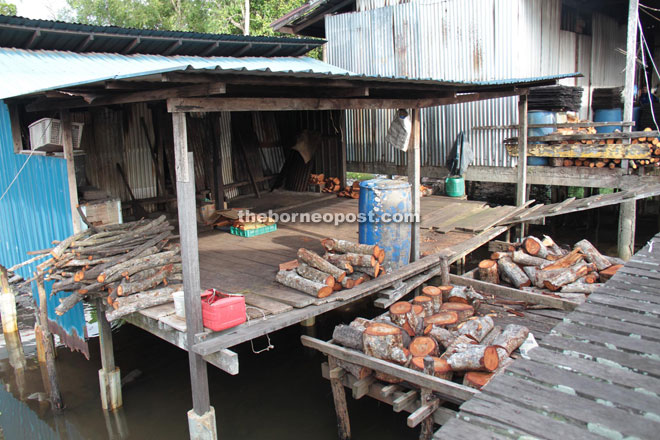
One of the traditional Ikan Tahai smokehouses in Kampung Punang.
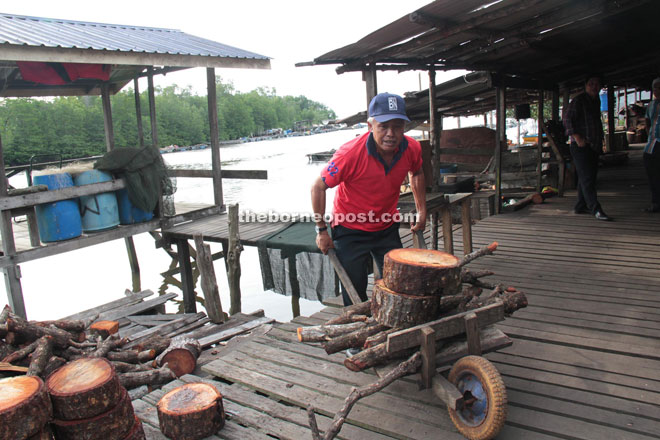
A villager sends firewood to the smokehouse.
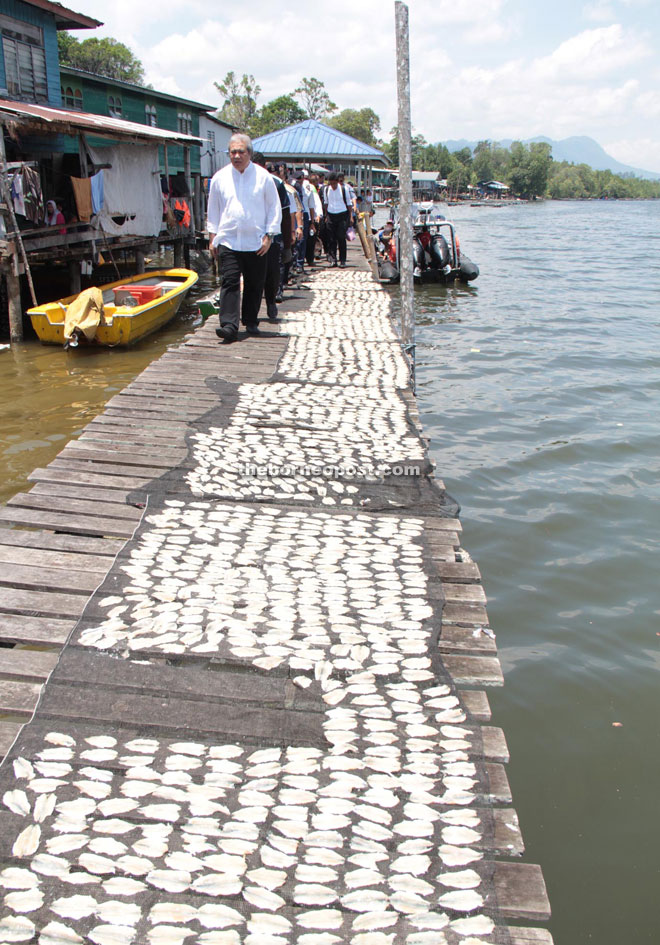
Rows of fish laid out to dry on the wooden jetty in Kampung Punang
THE humble smoked fish called ‘Ikan Tahai’ has earned its place as a patented intellectual property and is poised to spread its wings to markets beyond Sarawak, breathing life into this cottage industry from the northern tip of Sarawak.
From mere smoked fish to sambal and other delicacy derivatives, the authorities working hand-in-hand with the local producers are now promoting the product in Singapore, Peninsular Malaysia and the traditional markets in East Malaysia and Brunei.
Tahai-based product has been listed as intellectual property under the Geography Indicator (GI), a component of the Malaysia Intellectual Property Organisation (MyIPO).
This feat for the humble smoked fish product from Lawas is a game changer and a recognition of its uniqueness which has outsiders clambering for more once they have tasted it.
The Ministry of Domestic Trade, Co-operatives and Consumerism presented the MyIPO recognition to representatives of the Malaysian Fisheries Development Board and Lawas Area Fishermen Association at the launch of the Sarawak Entrepreneur and Consumerism Carnival on March 12.
Second Minister of Resource Planning and Environment Datuk Amar Awang Tengah Ali Hasan, who is also Minister of Industrial and Entreprenuer Development, Trade and Investment and Bukit Sari assemblyman, gave the thumbs up to this development and looked forward to more downstream activities and marketing down the road.
He was happy that tahai, a unique product from the waters off Lawas, popular among consumers in Lawas, Limbang, Brunei and beyond, was breaking out of its traditional ground and eyeing penetration into bigger markets, bringing cottage industry products from Lawas into the national and international scene.
A group of media representatives on a tour to Lawas were stunned when host Ali Akhbar declared ‘siapa makan dadah di Kampung Awat-Awat tidak akan ditangkap’ (anyone taking drugs in the village would not be arrested).
When Awang Tengah was saying the same thing on stage in Lawas recently, a renown Malaysian singer Datuk Jamal Abdillah immediately pronounced his innocence, exclaiming: “Demi Allah, saya tak buat lagi, saya dah taubat.” (By God, I don’t do drugs anymore! I have repented) The crowd roared with laughter.
A clean Jamal was of course being sporting and also poking fun at his own colourful past. Having spent his childhood in Brunei with his religious teacher dad, he knew exactly it (tahai) was a popular local delicacy.
Unlike those unfamiliar with the Brunei Malay culture and language in Lawas, ‘makan dadah’ is drugs-taking but here it means slurping the delicious local soup made of tamarind, onions, flavouring and the smoked fish ‘tahai’.
The local community believe that the ‘dadah soup’ has its own nutritional values and is effective in overcoming mild cold, fever and others. It could also be addictive for those who have tasted it and would return for more.
Tahai is synonymous with Kampung Awat Awat, Kampung Punang and to a certain extent Kuala Lawas. Kampung Awat-Awat is actually made up of four villages — Ujong, Tengah, Masjid and Bangsal – which sit on the left bank of Trusan River entering the Bay of Brunei.
A visit to Lawas is incomplete without returning home with tahai and Lawas is the sole producer of ‘tahai’ in Sarawak and the packed products are readily available at Lawas Tamu (market).
Smokehouses built with the help of the Agriculture Department is in the heart of this cottage industry where men from the fishing villages go out to catch the fish while the womenfolk smoke the fish into tahai.
The fish is smoked for two days using coal fire in a special smokehouse standing above the water’s surface on stilts that churn out ikan tahai from juvenile Tamban fish of about 10cm long.
Trays of the fish placed on wire nettings are turned over from time-to-time as it is smoked over a slow burning mangrove wood (bakau), producing the right type of smoke for the fish.
No preservative is used. With only sea salt, Tamban fish can be kept for a week and probably longer if refrigerated. After a two-day smoking process, tahai can last up to a month, preserved by sea salt and it can be eaten on its own or cooked in dishes.
Meanwhile, ‘ikan aur-aur bulat’ (rainbow sardine) is used to make satay fish whereby the meat is cured in brine and spice mixture for a day, and then smoked for another day. The price of satay fish is slightly more expensive.
Ikan Tahai delicacy enjoys good demand not only from locals but also visitors from Brunei, Limbang, Sabah and other areas of Sarawak.
The ‘tahai’ can fetch up to RM25 per kg or even higher when the fish is in short supply. The ikan tamban fishing season usually kicks off in earenest in July and the fishing grounds are far from the village during the off-season in April.
“The fish move in shoals and the experienced fishermen know what types they are and can accurately estimate the quantity of the fish,” said Lawas Area Fishermen Association chairman Awangku Tajudin Awangku Ibrahim.
Kampung Awat-Awat has more fish than Kampung Punang which, in turn, has more fish than Kuala Lawas. This is because of the villages’ proximity to the fishing grounds further out from the mouth of Sungei Lawas.
According to Tajudin, ikan tamban bulat is used to make fish satay because it has thicker flesh and fewer scales. Ikan tamban minyak, which has more oil, is used fresh in cooking, or dried under the sun, and ikan aur-aur which has thicker scales, is used to make ikan tahai.
For visitors without the time to visit the fishing villages, Tamu Lawas is a convenient place to buy raw ikan tamban, and ready packed ikan tahai and ikan pusu.
Ikan tahai, satay fish and ikan pusu contain protein and minerals besides being rich in Omega-3 fatty acids, and are low in mercury.
Although there are government marine and inland aquaculture projects to diversify the income sources of the fishing villages, the ikan tahai cottage industry should continue to be supported and promoted in a big way to sustain supply of the marine products so special to Lawas.
